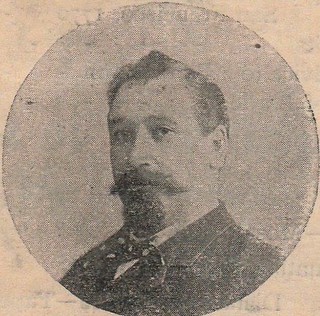
PREV ARTICLE
NEXT ARTICLE
FULL ISSUE
PREV FULL ISSUE
ERNEST HAQUETTE (1845-1911)John Lupia submitted the following information from his Encyclopedic Dictionary of Numismatic Biographies for this week's installment of his series. Thanks! As
always, this is an excerpt with the full article and bibliography available online. This week's subject is sometime coin dealer Ernest Haquette of San Francisco. -Editor
In 1865 Haquette moved to San Francisco, California, opening a Cafe. His brother Emile J. Haquette moved to Los Angeles, California. He became wealthy in his twenties dealing in the "Silver Rush" in Virginia City, Nevada, in what is known as the Comstock Lode. In 1875 he became partners with George Hageman in the Crystal Palace Saloon, 5 Kearny Street, San Francisco. The popularity of their saloon may have influenced the naming of the Palace Saloon in Copperopolis, California in 1883. Rulau Ca-Cp2 is the store card of the latter saloon. 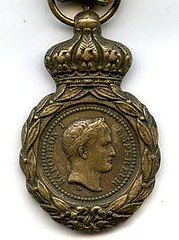 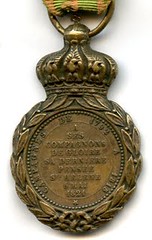 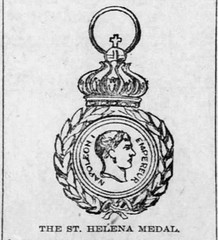 One of the 150 St. Helena Medals struck in 1857, inscribed May 5, 1821, made of gun metal, issued by a decree of Napoleon III in 1857, was given to his father by Napoleon III. His father devised it to Ernest Haquette on his death. In 1895 Ernest Haquette sent the medal to his brother Phillipe "Phil" Gerardi Haquette of St. Louis, Missouri. Phil Haquette willed the medal to his son John Henry Charles Louis Haquette. St. Louis Post Dispatch, Sunday, September 22, 1895, page 27. After the dissolution of his partnership with Hageman on Friday, October 2, 1896, he continued the Crystal Palace Saloon, as the sole successor at 5 Kearny Street. Sometime about February 1897 Haquette discovered a large amount of counterfeit silver half dollars were circulating at his saloon. He began to give them back to his patrons complaining and developed the reputation of a crank. Fearing loosing his clientele he stopped scrutinizing the coins and accepted them. When the newspapers got wind of it late May 1897 they ran a report suspecting them to have been minted in Mexico. The story ran with the headlines "Silver, And Yet Spurious, An Alarming Increase of Counterfeit Half-Dollars. Government Officials Nonplused." San Francisco Chronicle, Saturday, May 29, 1897, page 9. Afterwards he opened the Palace of Art at 16 Post Street, San Francisco on April 15, 1900. A public notice was first published announcing the opening in the San Francisco Call, Wednesday, April 12, 1899, page 7. This was a Cafe and Art Gallery that also displayed jewels, gems, and sold coins. He used to exhibit paintings by his cousin Georges Haquette. 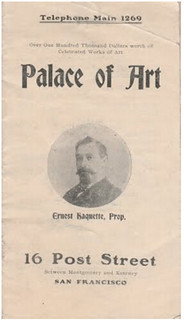 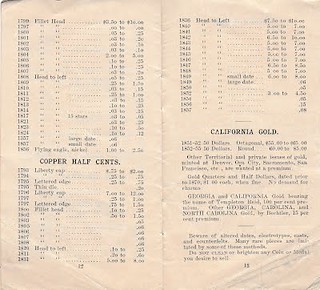 Pages 12-13 of Haquette's Coin Book. Note the warning on California fractional gold pieces stating that, "No demand for charms," and he only sells those prior to 1870. The implication is that from the 1870's on the fractional gold pieces were not considered worth collecting and deemed to be charms or trinkets. A few years later this view was substantiated by Henry Russell Drowne in the American Journal of Numismatics, April (1910), and by Edgar Holmes Adams in both The Numismatist, February (1913), and his book on California Pioneer Gold published that same year. In 1904, Haquette redesigned his saloon to accommodate women. This, of course, was a bit scandalous for the time and the newspaper reporters gloated on all the exotic curios describing them as both moral and immoral serving as a tease for the women to seek and touch. On June 24, 1905 he advertised a $500 reward for the return of an 83 carat diamond taken from his Palace of Art. This was most probably the 1869 discovery diamond in Dutch South Africa, called the "Star of South Africa". On April 18, 1906, Haquette suffered severe losses amounting to $200,000 from the San Francisco earthquake and fire. At the time he had earned $3,000 per month from his Palace of Art. During the fire Haquette paid several men to save the Crocker Home for the Poor next door using his own fire extinguishers, but to no avail. After the fire William Crocker heard of this and gave him $5,000 for his efforts. Hquette was ruined after the fire and could not develop his property at Santa Cruz as originally planned. On February 20, 1907 Haquette announced his plans to rebuild the Palace of Art. However, in July 1907 Ernest L. Heuter filed suit against him for $12,329 claiming debt from old mortgage of original Palace of Art that was destroyed in the 1906 fire. m congestive heart failure, on Friday, March 17, 1911, at his home 1647 Post Street, San Francisco. His funeral Mass was held at Notre Dame des Victoires. He was buried at Mount Olivet Cemetery. Though the 1910 Census lists him as a widower he was survived by his wife and daughter Mrs. Louis Frederick Burnette, and his brother Emile J. Haquette. Following his death several newspapers ran colorful accounts of his life since Haquette was a celebrity of San Francisco's social life. To read the complete article, see:  Wayne Homren, Editor The Numismatic Bibliomania Society is a non-profit organization promoting numismatic literature. See our web site at coinbooks.org. To submit items for publication in The E-Sylum, write to the Editor at this address: whomren@gmail.com To subscribe go to: https://my.binhost.com/lists/listinfo/esylum All Rights Reserved. NBS Home Page Contact the NBS webmaster 
|
